TurboGrafx-16
The TurboGrafx-16, known as the PC Engine[lower-alpha 1] in Japan and France, is a 16-bit fourth-generation home video game console designed by Hudson Soft and sold by NEC Home Electronics. It was released in Japan in 1987, and in North America in 1989. The Japanese model was imported and distributed in France in 1989, and the United Kingdom and Spain received a version based on the American model known as simply TurboGrafx. It was the first console released in the 16-bit era, although it used a modified 8-bit CPU. In Japan, the system was launched as a competitor to the Famicom, but the delayed United States release meant that it ended up competing with the Sega Genesis and later the Super Nintendo Entertainment System.
  | |
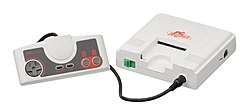 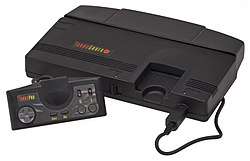 Original Japanese and French system (top) and the North American redesign (bottom). | |
| Manufacturer | NEC Home Electronics |
|---|---|
| Type | Home video game console |
| Generation | Fourth generation |
| Release date | |
| Lifespan | 1987–1994 |
| Discontinued | |
| Units sold | 5.8 million[1] |
| Media | HuCard |
| CPU | Hudson Soft HuC6280 |
| Display | 565×242 or 256×239, 512 color palette, 482 colors on-screen
|
| Successor | SuperGrafx |
The TurboGrafx-16 has an 8-bit CPU, a 16-bit video color encoder, and a 16-bit video display controller. The GPUs are capable of displaying 482 colors simultaneously, out of 512. With dimensions of just 14 cm × 14 cm × 3.8 cm (5.5 in × 5.5 in × 1.5 in), the Japanese PC Engine is the smallest major home game console ever made.[2][3] Games were released on HuCard cartridges and later the CD-ROM optical format with the TurboGrafx-CD add-on.
The TurboGrafx-16 failed to break into the North American market and sold poorly, which has been blamed on the delayed release and inferior marketing.[4] Despite the "16" in its name and the marketing of the console as a 16-bit platform, it used an 8-bit CPU, a marketing tactic that was criticized by some as deceptive.[5]
However, in Japan, the PC Engine, introduced into the market at a much earlier date, was very successful. It gained strong third-party support and outsold the Famicom at its 1987 debut, eventually becoming the Super Famicom's main rival.[6]
At least 17 distinct models of the TurboGrafx-16 were made, including portable versions and those that integrated the CD-ROM add-on.[7]
An enhanced model, the PC Engine SuperGrafx, was rushed to market in 1989. It featured many performance enhancements and was intended to supersede the standard PC Engine. It failed to catch on - only six titles were released that took advantage of the added power and it was quickly discontinued.
The entire series was discontinued in 1994. It was succeeded by the PC-FX, only released in Japan.
History
The TurboGrafx-16 or PC Engine was a collaborative effort between Hudson Soft, who created video game software, and NEC, a company which was dominant in the Japanese personal computer market with their PC-88 and PC-98 platforms. NEC lacked the vital experience in the video gaming industry so approached numerous video game studios for support. By pure coincidence, NEC's interest in entering the lucrative video game market coincided with Hudson's failed attempt to sell designs for then-advanced graphics chips to Nintendo. The two companies successfully joined together to then develop the new system.[3]
The PC Engine made its debut in the Japanese market on October 30, 1987, and it was a tremendous success. The PC Engine had an elegant, "eye-catching" design, and it was very small compared to its rivals.[4] This, coupled with a strong software lineup and third-party support from high-profile developers such as Namco and Konami gave NEC a temporary lead in the Japanese market.[3]
In 1988, NEC decided to expand to the American market and directed its U.S. operations to develop the system for the new audience. NEC Technologies boss Keith Schaefer formed a team to test the system. They found was a lack of enthusiasm in its name 'PC Engine' and also felt its small size was not very suitable to American consumers who would generally prefer a larger and "futuristic" design. They decided to call the system the 'TurboGrafx-16', a name representing its graphical speed and strength, and its 16-bit GPU. They also completely redesigned the hardware into a large, black casing. This lengthy redesign process and NEC's questions about the system's viability in the United States delayed the TurboGrafx-16's debut.[4]
The TurboGrafx-16 was eventually released in the New York City and Los Angeles test market in late August 1989. Disastrously for NEC, this was two weeks after Sega of America released the true 16-bit Genesis to test markets. Unlike NEC, Sega didn't waste time redesigning the original Japanese Mega Drive system.[8][4]
Sega quickly eclipsed the TurboGrafx-16 after its American debut. NEC's decision to pack-in Keith Courage in Alpha Zones, a Hudson Soft game unknown to western gamers, proved costly as Sega packed-in a port of the hit arcade title Altered Beast with the Genesis. NEC's American operations in Chicago were also overhyped about its potential and quickly produced 750,000 units, far above actual demand. This was very profitable for Hudson Soft as NEC paid Hudson Soft royalties for every console produced, whether sold or not. By 1990, it was clear that the system was performing very poorly and severely edged out by Nintendo and Sega's marketing.[4]
After seeing the TurboGrafx-16 suffer in America, NEC decided to cancel their European releases. Units for the European markets were already produced, which were essentially US models modified to run on PAL television sets, and branded as simply TurboGrafx. NEC sold this stock to distributors - in the United Kingdom Telegames released the TurboGrafx in 1990 in extremely limited quantities. This model was also released in Spain and Portugal through selected retailers.
From November 1989 to 1993, PC Engine consoles as well as some of its add-ons were imported from Japan by French licensed importer Sodipeng (Société de Distribution de la PC Engine, a subsidiary of Guillemot International). This came after considerable enthusiasm in the French press. The PC Engine was largely available in France and Benelux through major retailers. It came with French language instructions and also an AV cable to enable its compatibility with SECAM television set. Its launch price was 1,790 French francs.

By March 1991, NEC claimed that it had sold 750,000 TurboGrafx-16 consoles in the United States and 500,000 CD-ROM units worldwide.[9]
However, neither CD-based console would catch on and the North American console gaming market continued to be dominated by the Super NES and Genesis. In May 1994 Turbo Technologies announced that it was dropping support for the Duo, though it would continue to offer repairs for existing units and provide ongoing software releases through independent companies in the U.S. and Canada.[10]
The final licensed release for the PC Engine was Dead of the Brain Part 1 & 2 on June 3, 1999, on the Super CD-ROM² format.
Add-ons
TurboGrafx-CD/CD-ROM²
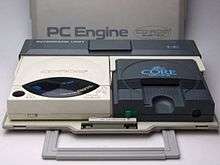
The CD-ROM² (pronounced CD-ROM-ROM) is an add-on attachment for the PC Engine that was released in Japan on December 4, 1988. The add-on allows the core versions of the console to play PC Engine games in CD-ROM format in addition to standard HuCards. This made the PC Engine the first video game console to use CD-ROMs as a storage media. The add-on consisted of two devices - the CD player itself and the interface unit, which connects the CD player to the console and provides a unified power supply and output for both.[11][12] It was later released as the TurboGrafx-CD in the United States in November 1989, with a remodeled interface unit in order to suit the different shape of the TurboGrafx-16 console.[13] The TurboGrafx-CD had a launch price of $399.99, and did not include any bundled games.[14] Fighting Street and Monster Lair were the TurboGrafx-CD launch titles; Ys Book I & II soon followed.
Super CD-ROM²
In 1991, NEC introduced an upgraded version of the CD-ROM² System known as the Super CD-ROM², which updates the BIOS to Version 3.0 and increases buffer RAM from 64kB to 256kB. This upgrade was released in several forms: the first was the PC Engine Duo on September 21, a new model of the console with a CD-ROM drive and upgraded BIOS/RAM already built into the system. This was followed by the Super System Card released on October 26, an upgrade for the existing CD-ROM² add-on that serves as a replacement to the original System Card. PC Engine owners who did not already own the original CD-ROM² add-on could instead opt for the Super-CD-ROM² unit, an updated version of the add-on released on December 13, which combines the CD-ROM drive, interface unit and Super System Card into one device.
Arcade Card
On March 12, 1994, NEC introduced a third upgrade known as the Arcade Card (アーケードカード, Ākēdo Kādo), which increases the amount of onboard RAM of the Super CD-ROM² System to 2MB. This upgrade was released in two models: the Arcade Card Duo, designed for PC Engine consoles already equipped with the Super CD-ROM² System, and the Arcade Card Pro, a model for the original CD-ROM² System that combines the functionalities of the Super System Card and Arcade Card Duo into one. The first games for this add-on were ports of the Neo-Geo fighting games Garō Densetsu 2 and Ryūkō no Ken. Ports of World Heroes 2 and Garō Densetsu Special were later released for this card, along with several original games released under the Arcade CD-ROM² standard. By this point support for both the TurboGrafx-16 and Turbo Duo was already waning in North America; thus, no North American version of either Arcade Card was produced, though a Japanese Arcade Card can still be used on a North American console through a HuCard converter.
Variations
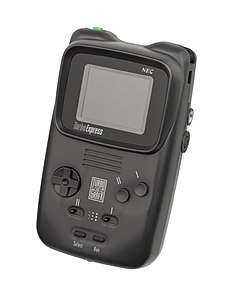 PC Engine CoreGrafx with CD-ROM² and interface unit |
 PC Engine Duo RX |
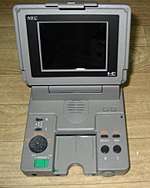 PC Engine LT |
.jpg) CoreGrafx II with Super CD-ROM² |
 PC Engine Shuttle |
 CoreGrafx I & II |
Many variations and related products of the PC Engine were released.
Core models
The PC Engine CoreGrafx is an updated model of the PC Engine, released in Japan on December 8, 1989. It has the same form factor as the original PC Engine, but it changes the color scheme from white and red to black and blue, and replaces the original's RF connector with an A/V port. It also used a revised CPU, the HuC6280a, which supposedly fixed some minor audio issues. A recolored version of the model, known as the PC Engine CoreGrafx II, was released on June 21, 1991. Aside from the different coloring (light grey and orange), it is nearly identical to the original CoreGrafx except that the CPU was changed back to the original HuC6280.
The PC Engine SuperGrafx, released on the same day as the CoreGrafx in Japan, is an enhanced variation of the PC Engine hardware with updated specs. This model has a second HuC6270A (VDC), a HuC6202 (VDP) that combines the output of the two VDCs, four times as much RAM, twice as much video RAM, and a second layer/plane of scrolling. It also uses the revised HuC6280a CPU, but the sound and color palette were not upgraded, making the expensive price tag a big disadvantage to the system. As a result, only five exclusive SuperGrafx games and two hybrid games (Darius Plus and Darius Alpha were released as standard HuCards which took advantage of the extra video hardware if played on a SuperGrafx) were released, and the system was quickly discontinued. Despite the fact that the SuperGrafx was intended to supersede the original PC Engine, its extra hardware features were not carried over to the later Duo consoles. The SuperGrafx has the same expansion port as previous PC Engine consoles, but requires an adapter in order to utilize the original CD-ROM² System add-on, due to the SuperGrafx console's large size.
The PC Engine LT is a model of the console in a laptop form, released on December 13, 1991 in Japan, retailing at ¥99,800. The LT does not require a television display (and does not have any AV output) as it has a built-in flip-up screen and speakers, just as a laptop would have, but unlike the GT the LT runs on a power supply. Its expensive price meant that few units were produced compared to other models. The LT has full expansion port capability, so the CD-ROM² unit is compatible with the LT the same way as it is with the original PC Engine and CoreGrafx. However, the LT requires an adapter to use the enhanced Super CD-ROM² unit.
HuCard-only models
The PC Engine Shuttle was released in Japan on November 22, 1989 as a less expensive model of the console, retailing at ¥18,800. It was targeted primarily towards younger players with its spaceship-like design and came bundled with a TurboPad II controller, which is shaped differently from the other standard TurboPad controllers. The reduced price was made possible by slimming down the expansion port of the back, making it the first model of the console that was not compatible with the CD-ROM² add-on. However, it does have a slot for a memory backup unit, which is required for certain games. The RF output used on the original PC Engine was also replaced with an A/V port for the Shuttle.
The PC Engine GT is a portable version of the PC Engine, released in Japan on December 1, 1990 and then in the United States as the TurboExpress. It can only play HuCard games. It has a 2.6-inch (66 mm) backlit, active-matrix color LCD screen, the most advanced on the market for a portable video game unit at the time. The screen contributed to its high price and short battery life, however, which dented its performance in the market. It shares the capabilities of the TurboGrafx-16, giving it 512 available colors (9-bit RGB), stereo sound, and the same custom CPU at 7.15909 MHz. It also has a TV tuner adapter as well as a two-player link cable.
Duo models
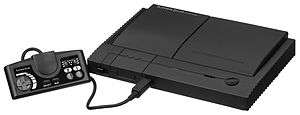 | |
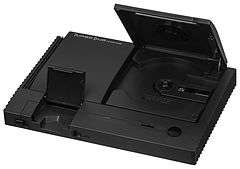 | |
| NEC/Turbo Technologies later released the TurboDuo, which combined the TurboGrafx-CD (with the new Super-System-Card on-board) and TurboGrafx-16 into one unit. | |
NEC Home Electronics released the PC Engine Duo in Japan on September 21, 1991, which combined the PC Engine and Super CD-ROM² unit into a single console. The system can play HuCards, audio CDs, CD+Gs, standard CD-ROM² games and Super CD-ROM² games. The North American version, the TurboDuo, was launched in October 1992. The American version of Duo was originally bundled with one control pad, an AC adapter, RCA cables, Ys Book I & II (a CD-ROM² title), and a Super CD-ROM² including Bonk's Adventure, Bonk's Revenge, Gate of Thunder and a secret version of Bomberman accessible via a cheat code. The system was also packaged with one random HuCard game which varied from system to system (Dungeon Explorer was the original HuCard pack-in for TurboDuo, although many titles were eventually used, such as Irem's Ninja Spirit and Namco's Final Lap Twin, and then eventually a random pick).
Two updated variants were released in Japan: the PC Engine Duo-R (on March 25, 1993) and the PC Engine Duo-RX (on June 25, 1994). The changes were mostly cosmetic, but the RX included a new 6-button controller.
Third-party models
The PC-KD863G is a CRT monitor with built-in PC Engine console, released on September 27, 1988 in Japan for ¥138,000. Following NEC's PCs' naming scheme, the PC-KD863G was designed to eliminate the need to buy a separate television set and a console. It output its signals in RGB, so it was clearer at the time than the console which was still limited to RF and composite. However, it has no BUS expansion port, which made it incompatible with the CD-ROM² System and memory backup add-ons.
The X1-Twin was the first licensed PC Engine-compatible hardware manufactured by a third-party company, released by Sharp in April 1989 for ¥99,800.[15] It is a hybrid system that can run PC Engine games and X1 computer software.
Pioneer Corporation's LaserActive supports an add-on module which allows the use of PC Engine games (HuCard, CD-ROM² and Super CD-ROM²) as well as new "LD-ROM²" titles that work only on this device. NEC also released their own LaserActive unit (NEC PCE-LD1) and PC Engine add-on module, under an OEM license.[16] A total of eleven LD-ROM2 titles were produced, with only three of them released in North America.
Other foreign markets
Outside North America and Japan, the TurboGrafx-16 was released in South Korea by a third party company, Haitai, under the name Vistar 16. It was based on the American version but with a new curved design. Daewoo Electronics distributed the PC Engine Shuttle into the South Korean market as well. The PC Engine was never officially released in continental Europe, but some companies imported them and made SCART conversions on a moderate scale. This mod improved the original video signal quality extensively and made the consoles work with SECAM televisions.
Technical specifications

The TurboGrafx-16 uses a Hudson Soft HuC6280 CPU—an 8-bit CPU modified with two 16-bit graphics processor—running at 7.6 MHz.[17] It features 8 KB of RAM, 64 KB of Video RAM, and the ability to display 482 colors at once from a 512 palette. The sound hardware, built into the HuC6280 CPU, includes a PSG running at 3.58 MHz and a 5-10 bit stereo PCM.
TurboGrafx-16 games use the HuCard ROM cartridge format, thin credit card-sized cards that insert into the front slot of the console. PC Engine HuCards feature 38 connector pins, while TurboGrafx-16 HuCards (alternatively referred to as "TurboChips") feature eight of these pins in reverse order as a region lockout method. The power switch on the console also acts as a lock that prevents HuCards from being removed while the system is powered on. The European release of the TurboGrafx-16 did not have its own PAL-formatted HuCards as a result of its limited release, with the system instead supporting standard HuCards and outputting a PAL 50 Hz video signal.[4]
Peripherals
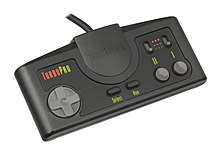
The TurboGrafx-16 controller, officially named the TurboPad, features a rectangular shape with a directional pad, two numbered "I" and "II" buttons, two rubber "Select" and "Start" buttons, and two "Turbo" switches for the I and II buttons with three speed settings. The switches allow for a single button press to register multiple inputs at once (for instance, this allows for rapid fire in scrolling shooters). The TurboGrafx-16 only has one controller port; NEC later released a peripheral named the TurboTap, which plugged into the port on the system and allowed for five other controllers to be plugged in at once for multiplayer games.
Many peripherals were produced for the TurboGrafx-16. The TurboStick is a joystick designed to replicate the standard control layout of arcade games from the era. The controller features a bright-red joystick, two input buttons, turbo switches, and two buttons that can speed up or slow down the framerate in games. Other similar joystick controllers were produced by third-party manufacturers, such as the Python 4 by QuickShot and the Stick Engine by ASCII Corporation. The TurboCable is an extension cable that increased the length of the TurboPad's wire length, allowing the system to be played from a further distance. The TurboBooster inserted into the back of the system and allowed it to render better visual and audio quality through composite cables. Hudson released the Ten no Koe 2 in Japan, which enabled the ability to save player progress in HuCard games.
Library
A total of 686 commercial games were released for the TurboGrafx-16. In North America, the system featured Keith Courage in Alpha Zones as a pack-in game, which was absent from the PC Engine. The console received strong third-party support in Japan, while the TurboGrafx-16 struggled to gain the attention of other developers. Hudson brought over many of its popular franchises, such as Bomberman, Bonk, and Adventure Island, to the system with graphically-impressive follow-ups. Hudson also designed and published several original titles such as Air Zonk and Dungeon Explorer. Compile published Alien Crush and Devil's Crush, two well-received virtual pinball games. Namco contributed several high-quality conversions of its arcade games, such as Valkyrie no Densetsu, Pac-Land, and Splatterhouse, as did Capcom with a port of Street Fighter II.
A large portion of the TurboGrafx-16's library is made up of horizontal and vertical-scrolling shooters. Examples include Konami's Gradius and Gradius II, Hudson's Super Star Soldier and Soldier Blade, Namco's Galaga '88, Irem's R-Type, and Taito's Darius Alpha. The console is also known for its platformers and role-playing games; Victor Entertainment's The Legendary Axe won numerous awards and is seen among the TurboGrafx-16's definitive titles. Ys I & II, a compilation of two games from Nihon Falcom's Ys series, was particularly successful in Japan.
Reception
In Japan, the PC Engine was very successful, and at one point was the top-selling console in the nation.[18] In North America and Europe the situation was reversed, with both Sega and Nintendo dominating the console market at the expense of NEC. Initially, the TurboGrafx-16 sold well in the U.S., but eventually it suffered from lack of support from third-party software developers and publishers.
In 1990, ACE magazine praised the console's racing game library, stating that, compared to "all the popular consoles, the PC Engine is way out in front in terms of the range and quality of its race games."[19] Reviewing the Turbo Duo model in 1993, GamePro gave it a "thumbs down". Though they praised the system's CD sound, graphics, and five-player capability, they criticized the outdated controller and the games library, saying the third party support was "almost nonexistent" and that most of the first party games were localizations of games better suited to the Japanese market.[20] In 2009, the TurboGrafx-16 was ranked the 13th greatest video game console of all time by IGN, citing "a solid catalog of games worth playing," but also a lack of third party support and the absence of a second controller port.[21]
The controversy over bit width marketing strategy reappeared with the advent of the Atari Jaguar console. Mattel did not market its 1979 Intellivision system with bit width, although it used a 16-bit CPU.[5]
Legacy
In 1994, NEC released a new console, the Japan-only PC-FX, a 32-bit system with a tower-like design; it enjoyed a small but steady stream of games until 1998, when NEC finally abandoned the video games industry. NEC supplied rival Nintendo with the RISC-based CPU, V810 (same one used in the PC-FX) for the Virtual Boy and VR4300 CPU for the Nintendo 64, released in 1995/1996, and both SNK updated VR4300 CPU (64-bit MIPS III) on Hyper Neo Geo 64, as too former rival Sega with a version of its PowerVR 2 GPU for the Dreamcast, released in 1997/1998.
A number of TurboGrafx-16 and TurboGrafx-CD games were released on Nintendo's Virtual Console download service for the Wii,[22] Wii U, and Nintendo 3DS, including several that were originally never released outside Japan.[23][24] In 2011, ten TurboGrafx-16 games were released on the PlayStation Network for play on the PlayStation 3 and PlayStation Portable in the North American region.
In 2010 Hudson released an iPhone application entitled "TurboGrafx-16 GameBox" which allowed users to buy and play a number of select Turbo Grafx games via in-app purchases.[25]
In 2016, rapper Kanye West's 8th solo album was initially announced to be titled "Turbo Grafx 16".[26][27] The title, however, was later changed to Ye.
In 2019, Konami announced at E3 2019 the TurboGrafx-16 Mini,[28] a dedicated console featuring many built-in games.[29] It's the first release of official hardware of the TurboGrafx-16 family since the closure of Hudson Soft in 2012. On March 6, 2020, Konami announced that the TurboGrafx-16 Mini and its peripheral accessories will be delayed indefinitely from its previous March 19, 2020, launch date due to the COVID-19 outbreak in China.[30][31][32]
See also
References
- "ウィークエンド経済 第765号 あの失敗がこう生きた [Weekend Economics Issue 765. That Mistake Lived On.]". Asahi Shinbun (Evening Edition) (in Japanese). Osaka, Japan. December 1, 2001.
- Guinness World Records Gamer's Edition (2008)
- McFerran, Damien (November 2, 2012). "Feature: The Making Of The PC Engine". Nintendo Life. Archived from the original on July 30, 2019.
- Nutt, Christian (September 12, 2014). "Stalled engine: The TurboGrafx-16 turns 25". Gamasutra. Archived from the original on June 27, 2017.
- Therrien, Carl; Picard, Martin (April 29, 2015). "Enter the bit wars: A study of video game marketing and platform crafting in the wake of the TurboGrafx-16 launch". New Media & Society. 18 (10): 2323–2339. doi:10.1177/1461444815584333.
- Sartori, Paul (April 2, 2013). "TurboGrafx-16: the console that time forgot (and why it's worth re-discovering)". The Guardian. Archived from the original on July 1, 2018.
- Stuart, Keith; Freeman, Will (February 27, 2016). "Why Kanye West is right to recommend the TurboGrafx-16". The Guardian. Archived from the original on June 22, 2017. Retrieved December 25, 2017.
- Kent, Steve L. (October 2, 2001). The Ultimate History of Video Games. Three Rivers Press. p. 413. ISBN 0-7615-3643-4. LCCN 2001036497.
- "Celebrating Software". Computer Gaming World. June 1991. p. 64. Retrieved November 17, 2013.
- "At the Deadline". GamePro (60). IDG. July 1994. p. 172.
- Top 25 Videogame Consoles of All Time, IGN. Retrieved June 14, 2010
- Wolf, Mark J. P. (2008). The video game explosion: a history from PONG to Playstation and beyond. ABC-CLIO. p. 119. ISBN 978-0-313-33868-7. Retrieved April 10, 2011.
- "TurboGrafx-CD System" (PDF). Computer Entertainer. Vol. 8 no. 9. December 1989. p. 11. Archived (PDF) from the original on September 25, 2018.
- "Toys R Us weekly ad". The Catoosa County News. December 5, 1990. Retrieved June 17, 2014.
- "スーパーPCエンジンファン" [Super PC Engine Fan] (in Japanese). Vol. 1. Tokuma Shoten Intermedia. January 15, 1994. Cite magazine requires
|magazine=(help) - "International News". Electronic Gaming Monthly. No. 54. January 1994. p. 94. Retrieved March 10, 2020.
- "United States patent 5059955".
- "What in the Name of Sam Hill is a PC Engine?". Electronic Gaming Monthly. Ziff Davis (70): 15. May 1995.
- ACE, issue 34 (July 1990), page 59
- "System Shopper". GamePro (53). IDG. December 1993. pp. 46–49.
- "TurboGrafx-16 is number 13". IGN. Retrieved July 5, 2011.
- "Hudson Entertainment – Video Games, Mobile Games, Ringtones, and More!". Hudsonent.com. Archived from the original on July 2, 2017. Retrieved July 5, 2011.
- "GDC 06: Satoru Iwata Keynote". IGN. March 23, 2006. Archived from the original on August 9, 2006. Retrieved July 5, 2011.
- "Virtual Console: Sega and Hudson games are a go! – Nintendo Wii Fanboy". Revolution Fanboy. March 23, 2006. Archived from the original on December 1, 2008. Retrieved July 5, 2011.
- Cowan, Danny (December 21, 2010). "Hudson Releases TurboGrafx-16 GameBox Emulator For iOS". Gamasutra. Archived from the original on July 12, 2016. Retrieved April 6, 2016.
- West, Kanye [@kanyewest] (February 26, 2016). "My next album is titled "Turbo Grafx 16" as of now…" (Tweet). Archived from the original on June 14, 2016 – via Twitter.
- Byford, Sam (February 27, 2016). "Kanye West says his new album is called Turbo Grafx 16 and coming this summer". The Verge. Archived from the original on September 6, 2018. Retrieved April 6, 2016.
- "PC Engine mini, PC Engine CoreGrafx mini, TurboGrafx-16 mini Official Website".
- Lanier, Liz (June 12, 2019). "Konami Releasing a Mini Version of TurboGrafx-16 With Pre-Loaded Games". Variety. Archived from the original on March 10, 2020. Retrieved March 10, 2020.
- Batchelor, James (March 6, 2020). "TurboGrafx-16 Mini indefinitely delayed due to coronavirus". GamesIndustry.biz. Archived from the original on March 7, 2020. Retrieved March 10, 2020.
- Yin-Poole, Wesley (March 6, 2020). "Konami delays PC Engine Core Grafx mini over coronavirus". Eurogamer. Archived from the original on March 10, 2020. Retrieved March 10, 2020.
- @konamieu (March 6, 2020). "[Notice] We have added the notice "Regarding the manufacturing and shipping delays of the PC Engine Core Grafx mini products due to the Coronavirus disease (COVID-19)" to the official website. Check here for more details: konami.com/games/pcemini/eu/en/ #CoreGrafx" (Tweet) – via Twitter.